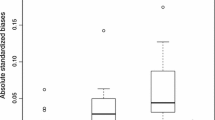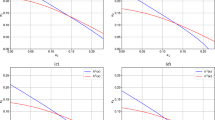Abstract
We consider the optimal portfolio problem with minimum guarantee protection in a defined contribution pension scheme. We compare various versions of guarantee concepts in a labor income coupled CPPI-framework with random future labor income. Besides classical deterministic guarantees we also introduce path-dependent guarantees. To ensure that there is no bias in the comparison, we obtain the optimal CPPI-multiplier for each guarantee framework via using a classical stochastic control approach.










Similar content being viewed by others
References
Balder, S., & Mahayni, A. (2010). Cash-lock comparison of portfolio insurance strategies Working paper, MSM, Duisburg University.
Bertrand, P., & Prigent, J.-L. (2005). Portfolio insurance strategies: OBPI versus CPPI. Finance, 26(1), 5–32.
Black, F., & Jones, R. (1987). Simplifying portfolio insurance. The Journal of Portfolio Management, 14, 48–51.
Boulier, J.-F., Huang, S., & Taillard, G. (2001). Optimal management under stochastic interest rates: The case of a protected defined contribution pension fund. Insurance: Mathematics and Economics, 28, 172–189.
Cairns, A. J. G., Blake, D., & Dowd, K. (2006). Stochastic lifestyling: Optimal dynamic asset allocation for defined contribution pension plans. Journal of Economic Dynamics and Control, 30(5), 843–877.
Davis, E. P. (1995). Pension funds: Retirement-income security and capital markets: An international perspective. Oxford: Oxford University Press.
Devolder, P., Janssen, J., & Manca, R. (2013). Stochastic methods for pension funds. London: Wiley.
Horsky, R. (2012). Barrier Option Pricing and CPPI-Optimization. Ph.D. thesis, TU Kaiserslautern.
Korn, R., & Krekel, M. (2002). Optimal portfolios with fixed consumption and income streams. Working paper, University of Kaiserslautern.
Korn, R., & Korn, E. (2001). Option pricing and portfolio optimization—Modern methods of financial mathematics. Providence, RI: American Mathematics Society.
Korn, R., & Kraft, H. (2002). A stochastic control approach to portfolio problems with stochastic interest rates. SIAM Journal on Control and Optimization, 40(4), 1250–1269.
Perold, A., & Sharpe, W. (1988). Dynamic strategies for asset allocation. Financial Analyst Journal, 16–27.
Tankov, P. (2010). Pricing and hedging gap risk. The Journal of Computational Finance, 13(3), 33–59.
Temocin, B. Z. (2015). Constant Proportion Portfolio Insurance in Defined Contribution Pension Plan Management. Doctoral dissertation, Middle East Technical University, Ankara, Turkey.
Author information
Authors and Affiliations
Corresponding author
Additional information
This study was supported by the Scientific and Technological Research Council of Turkey (TUBITAK) 2214-A Fellowship Program.
Appendix: Verifying the assumptions of the verification theorem
Appendix: Verifying the assumptions of the verification theorem
It is clear that our HJB equation has the same form as in Theorem 1. Therefore, to be able to apply the theorem, as a first step we need to prove that the optimal solution given by (11) is admissible. Then, as the second step, the proof of the following inequality should be given
1st step: To investigate the admissibility of \( m^* \), we give the next definition from Korn and Korn (2001).
Definition 1
(Definition 5.15 p. 225, Korn and Korn 2001) Let \( (\varOmega , {\mathcal {F}}, {\mathbb {P}}) \) endowed with the filtration \( \left\{ {\mathcal {F}}_t \right\} _{t \in [0,T]} \) be a probability space. A U-valued progressively measurable process \( u(t), t \in [t_0, t_1] \) is an admissible control if for all values \( x \in {\mathbb {R}}^n \) the stochastic differential Eq. (13) with initial condition \( X(t_0) = x \) possesses a unique solution \( \{ X(t)\}_{t \in [t_0, t_1]} \) and if we have
and
for all \( k \in {\mathbb {N}} \).
As \( m^* \) is found to be a constant, it is bounded and inequality (14) holds. Moreover, the solution of our controlled process given in (6) is found as
Therefore, we have the uniqueness of the solution as well as the following inequality
Hence, the control \( m^* \) is admissible.
2nd step: By (15), we have
with h(t) given as in (12). As C(t) is bounded by (15), we obtain
which completes the proof. Therefore, the solution \( m^* \) is the optimal control for our optimal control problem (7).
Rights and permissions
About this article
Cite this article
Temocin, B.Z., Korn, R. & Selcuk-Kestel, A.S. Constant proportion portfolio insurance in defined contribution pension plan management. Ann Oper Res 266, 329–348 (2018). https://doi.org/10.1007/s10479-017-2449-8
Published:
Issue Date:
DOI: https://doi.org/10.1007/s10479-017-2449-8




